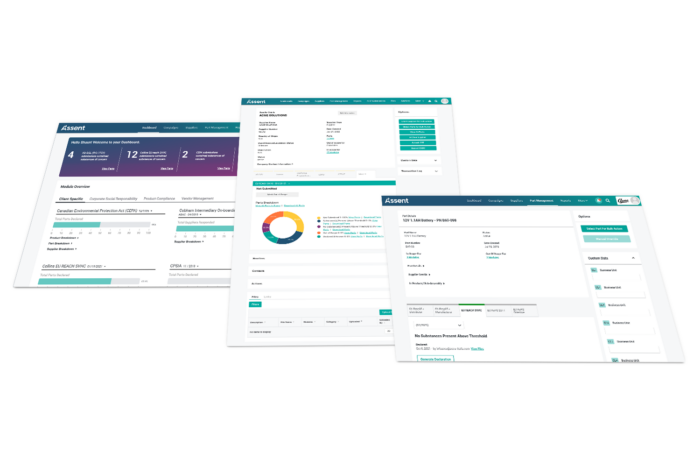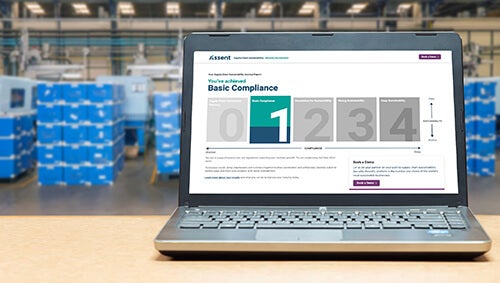Frequently Asked Questions About the EU Waste Framework Directive
Your Requirements Under the EU Waste Framework Directive & SCIP Database Explained

SCIP Database: Transparency in Hazardous Products
In 2018, the EU Waste Framework Directive (WFD) was amended to promote a circular economy and better communicate the presence of substances of very high concern (SVHCs) in articles to waste operators. The amended directive resulted in the creation of the Substances of Concern In articles, as such or in complex objects (Products) (SCIP) submission portal, also called the SCIP database.
What the SCIP Database Means for You
Companies placing products on the EU market are required to submit information to the SCIP database for any product that contains SVHCs. This means submissions are required for each article and substance present in a product, potentially requiring numerous related submissions for a single product. We have answered some of the most frequently asked questions we’ve received from companies about the SCIP database and the EU WFD.
The EU WFD (2008/98/EC) was initially implemented to prevent or reduce the adverse impacts of waste generation and management on the environment and human health.
The updated EU WFD establishes concepts and definitions related to waste management, including recycling and recovery. It outlines when waste should be considered a secondary raw material, allowing stakeholders to distinguish between waste and by-products. Additionally, it lays out waste management principles, requiring that waste be managed without endangering human health or the environment, with an emphasis on waste prevention and the long-term replacement or removal of harmful substances in products.
Businesses directly placing products on the EU marketplace are responsible for submitting information into the SCIP database where SVHCs are present above 0.1 percent weight by weight (w/w). In August 2022 the requirement to submit data to the SCIP database was extended to the rest of the EEA (Iceland, Liechtenstein, and Norway), and manufacturers and importers of products in these countries have been able to submit data to the SCIP database since November 7, 2022. Those importers often need to turn to their suppliers of articles to request information in order to fulfill their regulatory obligations. The following duty holders need to provide information to the SCIP database:
- EU producers and assemblers.
- EU importers.
- EU distributors of articles and other actors who place articles on the market.
- Distributors who distribute articles as received and perform no modifications.*
Generally speaking, companies in scope of the requirements of Article 33 of the Registration, Evaluation, Authorisation, and Restriction of Chemicals (REACH) Regulation (EC) No 1907/2006 are in scope of the EU WFD.
Retailers and other supply chain actors supplying articles directly to consumers are not obligated to submit information to European Chemicals Agency (ECHA).
*Required to submit into the SCIP database following the Simplified SCIP Notification (SSN) process.
The SCIP database was mandated on May 20, 2018, as part of an amendment to the EU WFD. The database has three main objectives:
- Decrease the generation of waste containing hazardous substances by supporting the substitution of substances of concern in articles placed on the EU market.
- Make information available on the presence of hazardous substances to further improve waste treatment operations.
- Allow authorities to monitor the use of substances of concern in articles and initiate appropriate actions over the whole lifecycle of articles, including at their waste stage.
The EU WFD is the piece of legislation that governs how waste is managed at the end of a product’s life cycle.
The SCIP database is a key part of the implementation of the directive toward this goal.
Products that have been sold into the European Economic Area (EEA) before January 5, 2020, do not have to be entered into the database at this time.
However, all articles that will be placed on the market in the EEA as of January 5, 2020, will have to be entered into the database, whether or not they were previously sold into the EEA.
ECHA is in charge of the implementation and ongoing maintenance of the database.
Only EEA companies are in scope of the EU WFD. However, your customers’ duty to make SCIP submissions may represent a significant business requirement for you if your products sold into the EU contain articles with SVHCs above the 0.1% w/w threshold.
Yes. When the EU WFD came out as a Directive in 2018, the 27 EU member states had to transpose it into national regulations. Once all 27 member states transposed the directive, its application was extended to EEA countries.
As of August 1, 2022, all European Economic Area (EEA) countries, like Iceland, Liechtenstein, and Norway, are bound by SCIP reporting requirements.
Companies had to be ready to submit data into the SCIP database since January 5, 2021. When the REACH SVHC Candidate List updates every six months, it triggers SCIP database reporting requirements for the newly added substances. This means that ongoing data collection is required from suppliers in order for SCIP duty holders to fulfill their legal requirements.
ECHA made a test version of the SCIP database available to companies in 2019 so they could connect and test data prior to the go-live date.
The exact enforcement penalties will be determined by the EU member state in which the violation occurs. Enforcement and penalties are always a member state competence. That said, the new Market Surveillance Regulation (EU) 2019/1020 empowers member states to conduct more stringent market surveillance and enforcement to prevent non-compliant products from circulating on the EU market. The regulation also requires member states to ensure that their penalties are “effective, proportionate, and dissuasive.” Member states had until July 5, 2020, to transpose the EU WFD requirements into national law.
A first importer is defined as the entity that places a product onto the EU market.
The first importer is responsible for submitting into the SCIP database on behalf of non-EU-based manufacturers of components or products that contain SVHCs over 0.1% w/w. The SCIP submission must be done for the final product as sold, be that a component such as a screw or a complex object (product) such as an electronic power supply. The SCIP submission file (called a dossier) must contain data on the smallest article that contains the SVHC within the product (complex object) as sold so that the data is presented in a hierarchical structure. Note that any company importing has a duty to declare, but could use a Simplified Notification if knowledgeable of the First Importer Dossier ID.
Yes, two concepts exist:
- Simplified Notification (SSN) — once a business places the same product on the market (without any changes, including brand, names, IDs), they can claim duty by creating a so-called SSN, which will create a different ID for the same dossier data. Maintenance of the Dossier is up to the original owning party. This is a scenario commonly used for distribution and replacement parts that are sold by their OEM. Note: if that party ceases duty for the product (not selling anymore, going out of business), the SSN holders must ensure continued updates by creating new full dossiers and no longer issuing the SSN.
- Reference — if a part having a SCIP Number is used in an assembly, the assembly duty holder may reference the dossier ID instead of creating a full declaration for the part. This allows for simpler data and change management. Note: the same restriction applies as for SSN.
The substances in scope for EU WFD match the REACH SVHC Candidate List. Where an SVHC is identified on the REACH Candidate List and is present in an article above 0.1 percent w/w, the supplier of that article must report it to the SCIP database. This does not change if the article is then assembled into complex objects. This is because the obligation under Article 9 of the Waste Framework Directive is an extension of the obligation under REACH Article 33 which requires suppliers of articles that contain an SVHC over 0.1 percent w/w to inform the recipient of the article about the presence of the SVHC.
An article is defined in REACH Article 3(3) as “an object which during production is given a special shape, surface or design which determines its function to a greater degree than does its chemical composition.” The European Court of Justice held in their seminal 2015 ruling that an article remains an article even if assembled together with other articles into a bigger product, forming a complex object. The presence and concentration of the SVHC should nevertheless be calculated at the smallest article level. Products or components that do not contain SVHCs do not have to be reported to the SCIP database.
Raw materials or mixtures are not in scope. The EU REACH and CLP (EC) No 1272/2008 Regulations regulate the classification and use of substances and mixtures on the EU market.
Even if a supplier enters all SVHCs into the SCIP database, they still must provide sufficient data to the recipient of the article to allow for the safe use of the article. This is primarily for two reasons.
Under Article 33 of the EU REACH Regulation, SVHC content in articles must be identified to downstream users, so companies are able to inform on the SVHCs in complex objects and allow for the safe use of the article or complex object. The REACH Article 33 requirement is therefore focused on the safe use of articles containing SVHCs in the value chain. The EU WFD addresses the handling of products (articles and complex objects) containing SVHCs at the end of life and is applicable to all products with SVHC content over 0.1 percent w/w at the smallest article level.
Furthermore, the SCIP Dissemination Portal is not a suitable means of data exchange in a business context. Its data is also not clearly identifiable and there is no way to digitally integrate the provided data. As with most industrially supplied parts, the sheer amount of data intake renders any manual copying of the SCIP data both unreliable, error-prone, and very inefficient.
Only data on articles containing REACH Candidate List substances in a concentration above the 0.1 percent w/w threshold must be collected. Besides administrative contact details, suppliers of articles need to provide extensive article and substance information, such as article name and primary identifier, article category (based on a subset of the EU Customs or TARIC Codes, material or mixture category, substance concentration range, if the article is produced in the EU, etc.).
It is expected that SCIP database submissions will require the aggregation of data collected from the supply chain for formatting and manual upload of article-related data in the International Uniform Chemical Information Database (IUCLID) i6z file format into the IUCLID. This is the same format currently used to enter chemical substance, mixture, and other related data types into the Chemical Management Database for REACH substance registrations. Data can be submitted in the following ways:
- Using the IUCLID software installed on a computer to generate a dossier file with the article file attached and then submit it online to the ECHA submission portal.
- Using the IUCLID cloud service to create the article file and dossier file and submit it to the ECHA submission portal.
- A system-to-system (S2S) connection via an API for IT solution providers to transmit and receive data, which was developed by the ECHA SCIP IT user group. This is also part of Assent’s service offering for clients to do their SCIP submissions. The S2S approach is considered to be the most efficient approach as it may leverage data already existing in other systems. It is also the by far most used means, according to ECHA statistics.
The International Uniform Chemical Information Database (IUCLID) is software used to record, store, maintain, and exchange data on intrinsic and hazardous properties of chemical substances. It was co-developed by ECHA and the Organization for Economic Cooperation and Development (OECD). The structure of IUCLID Version 6.4 released in October 2019 was expanded to include the data fields required for SCIP submissions. New versions of IUCLID are regularly released by OECD.
Although IPC-1754, IPC-1752B, and IEC-62474 are acceptable formats to collect supply chain data, IPC-1752A is not a suitable format to collect data for the SCIP database. This is because companies will have to extract data from those declaration formats to submit into the SCIP database.
SCIP submissions begin with the submission of lower-level part data which in turn generates SCIP IDs. Records for complex objects may be created by referencing lower-level article/part IDs, which eases data change management. Alternatively, companies may choose to provide full dossiers, which implies full data ownership, but also minimizes the risk of unwanted changes to reference data, as there is no notification mechanism under SCIP that would allow companies to monitor database changes.
Note that importing into the EU does not trigger a need to generate lower-level part dossiers, as they are not directly placed on the market, but only a need for a product-level dossier, which would then include data structures representing parts/articles as needed
The Primary Article Identifier is the identifier unique to the legal entity for the article (product) submitted to the database. It should allow for identifying the article, hence part numbers are frequently used as ID. For end-consumer products, it is mandated that the product EAN be the Primary Identifier.
The public-facing section of the SCIP database is accessible to the general public. ECHA ensures the protection of confidential business information where justified. For example, the required mandatory data that is used to establish links between actors in the same supply chain is not publicly accessible.
Note that looking up data in the Dissemination Portal without using the SCiP ID will potentially lead to ambiguous results, as only the primary ID and names are shown for identification, without brand or similar context to identify the manufacturer. If different companies place products with identical IDs/names into the database, all these will be found and it becomes difficult to impossible to understand the correct data.
Confidential business data will be protected by providing data only as needed, depending on use case, as outlined in a presentation from ECHA. Some examples of use cases are:
- Waste operators leveraging data to be safer and more efficient in recycling processes
- Consumers being able to make informed decisions and properly dispose of products
- Market surveillance authorities supporting monitoring and enforcement of regulations
Note that ECHA does not disclose any information on manufacturers, distributors, etc. It is impossible to understand from the dissemination portal who manufactured the product or parts, unless the submissions themselves contain confidential information in part number or name.
Yes, the data required for successful SCIP submissions will update at least twice per year as the REACH Candidate List grows. Companies will also be required to update their dossiers as substance, article, and/or company information changes. While ECHA announced they would not make any significant changes for the foreseeable future (2022/2023), REACH updates and subsequent changes to the WFD might trigger such a need.


How Assent Helps
Assent has supported hundreds of companies manage their REACH requirements, and has been involved with the SCIP IT user group during the development of the database. With this unique insight, Assent helps you fulfill the legal requirements by offering a deep understanding of the new requirements for companies, and providing a complete solution from scoping to data submission — something no other solution can offer.





